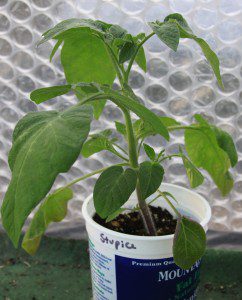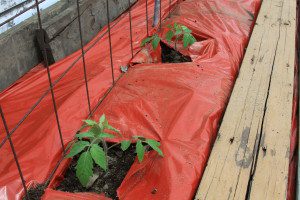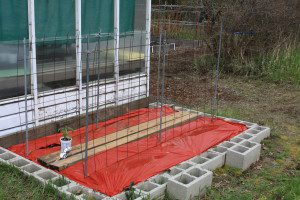Starting Tomatoes from Seed

If you live in a northern climate, I hope you haven’t planted your tomatoes from seed yet! Yes, it’s easy to get excited but it’s still too early.
I used to start my tomato seeds indoors in early February. I figured the plants need to be large and robust before planting them out into the garden in mid-May. I quickly discovered that they’ll grow rapidly indoors and before you know it, you’ve got leggy plants that flop all over the place. That’s definitely not a good start!
So the following year, I decided to wait a whole two weeks (ha) and see if that made a difference. The result? Floppy, leggy plants.
 OK, let’s wait until, gulp, the 1st of March. The result? Yes, still floppy, leggy plants. Darn.
OK, let’s wait until, gulp, the 1st of March. The result? Yes, still floppy, leggy plants. Darn.
Then I decided to walk on the wild side and wait all the way until the 15th of March. And still I had floppy, leggy plants! Argh.
This year, I am going to try waiting until the first of April. I say “try” because I honestly don’t know if I can wait that long, but it will definitely be after the middle of March.
So what method do I use to start my tomato plants and produce robust plants for the garden?
But first, I should probably share my favorite cultivars with you. For slicing tomatoes, you can’t be ‘Jetstar’; I’m crazy about ‘Sungold’ cherry tomatoes; and my two favorite paste tomatoes are ‘Italian Pompeii’ and ‘Amish Paste – Kapuler’. That doesn’t mean there aren’t a whole lot of amazing varieties out there, but for now, those are my go-to tomatoes.
I plant the tomatoes in flats and place them under grow lights. Once the seedlings have at least one pair of true leaves, I transplant each one into an empty quart-size yogurt container. When a gardener re-pots (or pots up) a plant into a new container, I realize it’s typical to just go with a container that is a little bit larger than the previous one it was in.
But I find the tomato seedlings do great with this jump in pot size and it saves me time by not having to do multiple transplantings into large pots.
I have a small, unheated greenhouse so that’s where I move the seedlings to once they’re in their yogurt containers. I watch the temperatures carefully and, if necessary, will cover the plants with a sheet of floating row cover to give them a little extra frost protection.
Once the temperatures have stabilized in mid-May, I cover the garden beds that they’ll be growing in with a sheet of red plastic mulch (a.k.a. SCRM tomato mulch). This does two things: it increases the soil temperature –which heat-lovers like tomatoes love — and it increases the amount of light that is reflected up into the plants. You wouldn’t believe the difference in productivity one gets by using this plastic mulch!
 At planting time, I cut an “X” into the mulch for each plant and plant the seedlings deeply to encourage additional root growth along the stems. I water them in well and cover the beds with floating row cover for about two weeks, to keep the air around the plants warm.
At planting time, I cut an “X” into the mulch for each plant and plant the seedlings deeply to encourage additional root growth along the stems. I water them in well and cover the beds with floating row cover for about two weeks, to keep the air around the plants warm.
You also better believe I watch the weather like a hawk for those first couple of weeks! There’s no point in letting a late frost ruin my carefully-tended seedlings, right?
 To support the plants, I don’t use tomato cages anymore. Instead, I plant the seedlings on either side of a vertical sheet of concrete reinforcing wire and use a bit of twine to attach the plants to it. This works great and is much easier than using cages.
To support the plants, I don’t use tomato cages anymore. Instead, I plant the seedlings on either side of a vertical sheet of concrete reinforcing wire and use a bit of twine to attach the plants to it. This works great and is much easier than using cages.
I hope this information will help you get your tomato plants off to a good start. Look for more tomato-growing (as well as other veggies) as we get into the garden season.
